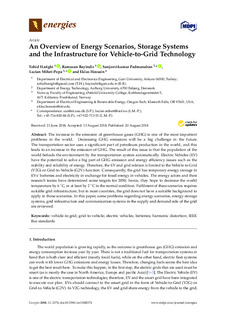An Overview of Energy Scenarios, Storage Systems and the Infrastructure for Vehicle-to-Grid Technology
| dc.contributor.author | Harighi, Tohid | |
| dc.contributor.author | Bayindir, Ramazan | |
| dc.contributor.author | Sanjeevikumar, Padmanaban | |
| dc.contributor.author | Mihet-Popa, Lucian | |
| dc.contributor.author | Hossain, Eklas | |
| dc.date.accessioned | 2019-05-16T13:14:37Z | |
| dc.date.available | 2019-05-16T13:14:37Z | |
| dc.date.created | 2018-09-06T10:55:45Z | |
| dc.date.issued | 2018 | |
| dc.identifier.citation | Energies. 2018, 11 (8), 1-18. | nb_NO |
| dc.identifier.issn | 1996-1073 | |
| dc.identifier.uri | http://hdl.handle.net/11250/2597910 | |
| dc.description.abstract | The increase in the emission of greenhouse gases (GHG) is one of the most important problems in the world. Decreasing GHG emissions will be a big challenge in the future. The transportation sector uses a significant part of petroleum production in the world, and this leads to an increase in the emission of GHG. The result of this issue is that the population of the world befouls the environment by the transportation system automatically. Electric Vehicles (EV) have the potential to solve a big part of GHG emission and energy efficiency issues such as the stability and reliability of energy. Therefore, the EV and grid relation is limited to the Vehicle-to-Grid (V2G) or Grid-to-Vehicle (G2V) function. Consequently, the grid has temporary energy storage in EVs’ batteries and electricity in exchange for fossil energy in vehicles. The energy actors and their research teams have determined some targets for 2050; hence, they hope to decrease the world temperature by 6 °C, or at least by 2 °C in the normal condition. Fulfilment of these scenarios requires suitable grid infrastructure, but in most countries, the grid does not have a suitable background to apply in those scenarios. In this paper, some problems regarding energy scenarios, energy storage systems, grid infrastructure and communication systems in the supply and demand side of the grid are reviewed. | nb_NO |
| dc.language.iso | eng | nb_NO |
| dc.subject | Vehicle-to-grid | nb_NO |
| dc.subject | Grid-to-vehicle | nb_NO |
| dc.subject | Electric vehicles | nb_NO |
| dc.subject | Batteries | nb_NO |
| dc.subject | Harmonic distortion | nb_NO |
| dc.subject | IEEE Bus standards | nb_NO |
| dc.title | An Overview of Energy Scenarios, Storage Systems and the Infrastructure for Vehicle-to-Grid Technology | nb_NO |
| dc.type | Journal article | nb_NO |
| dc.type | Peer reviewed | nb_NO |
| dc.description.version | publishedVersion | nb_NO |
| dc.source.pagenumber | 1-18 | nb_NO |
| dc.source.volume | 11 | nb_NO |
| dc.source.journal | Energies | nb_NO |
| dc.source.issue | 8 | nb_NO |
| dc.identifier.doi | 10.3390/en11082174 | |
| dc.identifier.cristin | 1607182 | |
| cristin.unitcode | 224,50,0,0 | |
| cristin.unitname | Avdeling for ingeniørfag | |
| cristin.ispublished | true | |
| cristin.fulltext | original | |
| cristin.qualitycode | 1 |
Tilhørende fil(er)
Denne innførselen finnes i følgende samling(er)
-
Tidsskrift- og avisartikler. IR [71]
Samlingen inneholder bidrag fra ansatte ved Avdeling for ingeniørfag publisert som tidsskrift- og avisartikler
